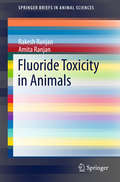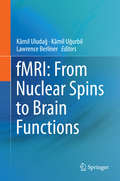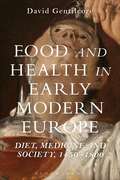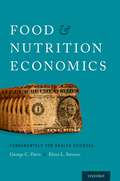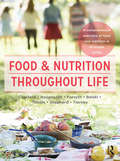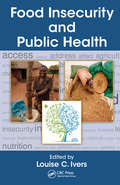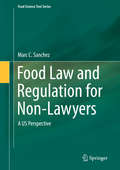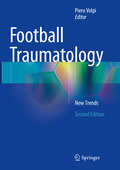- Table View
- List View
Fluoride Toxicity in Animals (SpringerBriefs in Animal Sciences)
by Rakesh Ranjan Amita RanjanThis book describes in detail various aspects of fluoride toxicity in animals. Animals, like human beings, suffer from the toxic effects of excess fluoride intake. They show pathological changes in their teeth and bone, together with a marked reduction in appetite, productive and reproductive potentials, which can result in severe economic losses in the dairy industry. Laboratory and wild animals also suffer from this ailment. Animal suffering and economic losses alike can be minimized through early diagnosis of the problem and by adopting suitable preventive and therapeutic measures. The book details the susceptibility of different animal species, important sources of toxicity, clinical signs and symptoms, pathophysiology, diagnostic methods, preventive and therapeutic approaches. It offers a valuable resource for scientists working in the fields of toxicology, veterinary science, animal nutrition, and environmental science, as well as for public health workers, animal welfare activists, public health veterinarians, field veterinarians, medical professionals and all others interested in the subject.
fMRI: From Nuclear Spins to Brain Functions (Biological Magnetic Resonance #30)
by Kâmil Uludağ Kâmil Uğurbil Lawrence BerlinerThis volume explores the revolutionary fMRI field from basic principles to state-of-the-art research. It covers a broad spectrum of topics, including the history of fMRI's development using endogenous MR blood contrast, neurovascular coupling, pulse sequences for fMRI, quantitative fMRI; fMRI of the visual system, auditory cortex, and sensorimotor system; genetic imaging using fMRI, multimodal neuroimaging, brain bioenergetics and function and molecular-level fMRI. Comprehensive and intuitively structured, this book engages the reader with a first-person account of the development and history of the fMRI field by the authors. The subsequent sections examine the physiological basis of fMRI, the basic principles of fMRI and its applications and the latest advances of the technology, ending with a discussion of fMRI’s future. fMRI: From Nuclear Spins to Brain Function, co-edited by leading and renowned fMRI researchers Kamil Ugurbil, Kamil Uludag and Lawrence Berliner, is an ideal resource for clinicians and researchers in the fields of neuroscience, psychology and MRI physics.
Focal Peripheral Neuropathies: Imaging, Neurological, and Neurosurgical Approaches
by Götz Penkert Josef Böhm Thomas SchelleEvery neurosurgeon as well as many surgeons in other disciplines, including plastic and orthopedic surgeons, may unexpectedly be confronted with an entrapment syndrome or a nerve trauma. With a view to preventing costly transfers to expert clinics, this manual for practitioners offers optimized step-by-step figures illustrating how best to approach every relevant nerve lesion. Clear advice is also provided on differential diagnosis from inflammatory neuropathies, which will assist in avoiding false indications for surgery. This is a true manual for practitioners that offers excellent guidance for all surgeons while in the operating theater.
Focal Therapy of Prostate Cancer: An Emerging Strategy for Minimally Invasive, Staged Treatment
by Stefan Thüroff Christian G. ChaussyThis book provides a 2015 state of the art update on the hot topic of focal prostate cancer therapy, which offers a means of preserving the prostate and avoiding major side-effects associated with conventional treatment strategies. In so doing, focal therapy meets the desire of many patients, especially those with low-risk disease, to avoid or postpone radical therapies in order to preserve quality of life. A wide range of aspects are covered, including the role of imaging-guided targeted biopsies, the pros and cons of surveillance in comparison with focal therapy, focal hemiablation and focal salvage therapy, multifocal therapies, focal cryotherapy. The potential role of various new diagnostic technologies as well as specific therapeutic devices as "Focal.One" robotic high-intensity focused ultrasound are explained. The authors are all international experts who are long-term proponents of non-invasive treatment of prostate cancer. "Focal Therapy of Prostate Cancer" will be an invaluable source of information for urologists, oncologists, radiation oncologists, and general practitioners, and also for patients wishing to learn more about this new treatment option.
Food and Health in Early Modern Europe: Diet, Medicine and Society, 1450-1800
by David GentilcoreCHOICE Outstanding Academic Title 2016Food and Health in Early Modern Europe is both a history of food practices and a history of the medical discourse about that food. It is also an exploration of the interaction between the two: the relationship between evolving foodways and shifting medical advice on what to eat in order to stay healthy. It provides the first in-depth study of printed dietary advice covering the entire early modern period, from the late-15th century to the early-19th; it is also the first to trace the history of European foodways as seen through the prism of this advice. David Gentilcore offers a doctor's-eye view of changing food and dietary fashions: from Portugal to Poland, from Scotland to Sicily, not forgetting the expanding European populations of the New World. In addition to exploring European regimens throughout the period, works of materia medica, botany, agronomy and horticulture are considered, as well as a range of other printed sources, such as travel accounts, cookery books and literary works. The book also includes 30 illustrations, maps and extensive chapter bibliographies with web links included to further aid study.Food and Health in Early Modern Europe is the essential introduction to the relationship between food, health and medicine for history students and scholars alike.
Food and Health in Early Modern Europe: Diet, Medicine and Society, 1450-1800
by David GentilcoreCHOICE Outstanding Academic Title 2016Food and Health in Early Modern Europe is both a history of food practices and a history of the medical discourse about that food. It is also an exploration of the interaction between the two: the relationship between evolving foodways and shifting medical advice on what to eat in order to stay healthy. It provides the first in-depth study of printed dietary advice covering the entire early modern period, from the late-15th century to the early-19th; it is also the first to trace the history of European foodways as seen through the prism of this advice. David Gentilcore offers a doctor's-eye view of changing food and dietary fashions: from Portugal to Poland, from Scotland to Sicily, not forgetting the expanding European populations of the New World. In addition to exploring European regimens throughout the period, works of materia medica, botany, agronomy and horticulture are considered, as well as a range of other printed sources, such as travel accounts, cookery books and literary works. The book also includes 30 illustrations, maps and extensive chapter bibliographies with web links included to further aid study.Food and Health in Early Modern Europe is the essential introduction to the relationship between food, health and medicine for history students and scholars alike.
Food and Nutrition Economics: Fundamentals for Health Sciences (Food and Public Health)
by George C. Davis Elena L. SerranoWinner of the 2017 Quality of Communication Award presented by The Agricultural and Applied Economics Association As the importance of food and nutrition becomes more widely recognized by practitioners and researchers in the health sciences, one persisting gap in the knowledge base remains: what are the economic factors that influence our food and our health? Food and Nutrition Economics offers a much-needed resource for non-economists looking to understand the basic economic principles that govern our food and nutritional systems. Comprising both a quick grounding in nutrition with the fundamentals of economics and expert applications to food systems, it is a uniquely accessible and much-needed bridge between previously disparate scholarly and professional fields. This book is intended for upper level undergraduates, graduate students, and health professionals with no background in economics who recognize that economics affects much of their work. Concerned because previous encounters with economics have been hampered by math hurdles? Don't be; this book offers a specialized primer in consumer economics (including behavioral economics of food consumption), producer economics, market-level analysis, cost-effectiveness, and cost-benefit analysis, all in an accessible and conversational manner that requires nothing more than middle-school math acumen. Grounding these lessons in contemporary issues such as soft drink taxes, food prices, convenience, nutrition education programs, and the food environment, Food and Nutrition Economics is an innovative and needed entry in the rapidly expanding universe of food studies, health science, and their related fields.
Food and Nutrition Throughout Life: A comprehensive overview of food and nutrition in all stages of life
by Catherine Itsiopoulos Adrienne Forsyth Regina Belski Antonia Thodis Sue Shepherd Audrey Tierney Sharon CroxfordNutritional requirements vary greatly according to age and lifestyle. This evidence-based, comprehensive text is a complete guide to eating habits across age and population groups. It provides the recommendations for intakes of nutrients and foods, and diet to achieve optimum health.Chapters systematically examine the nutritional issues for individuals from preconception, pregnancy and breastfeeding through to adulthood and old age. The text features an overview of dietary patterns by age group based on national scientific survey data together with the latest recommendations for optimum nutrition to maintain well-being and address specific health concerns. The final section examines nutrition issues for specific populations including indigenous groups, athletes and the disadvantaged. Throughout the text, key points are illustrated by case studies and the reader's knowledge is tested via quizzes and study questions.With chapters from leading nutrition researchers and educators in Australia, New Zealand and Asia, this is an excellent introduction to nutrition through the lifespan.'A comprehensive overview and detailed discussion of food and nutrition topics for all ages and stages of life.' - Robynne Snell, Curtin University
Food and Nutrition Throughout Life: A comprehensive overview of food and nutrition in all stages of life
by Catherine Itsiopoulos Adrienne Forsyth Regina Belski Antonia Thodis Sue Shepherd Audrey Tierney Sharon CroxfordNutritional requirements vary greatly according to age and lifestyle. This evidence-based, comprehensive text is a complete guide to eating habits across age and population groups. It provides the recommendations for intakes of nutrients and foods, and diet to achieve optimum health.Chapters systematically examine the nutritional issues for individuals from preconception, pregnancy and breastfeeding through to adulthood and old age. The text features an overview of dietary patterns by age group based on national scientific survey data together with the latest recommendations for optimum nutrition to maintain well-being and address specific health concerns. The final section examines nutrition issues for specific populations including indigenous groups, athletes and the disadvantaged. Throughout the text, key points are illustrated by case studies and the reader's knowledge is tested via quizzes and study questions.With chapters from leading nutrition researchers and educators in Australia, New Zealand and Asia, this is an excellent introduction to nutrition through the lifespan.'A comprehensive overview and detailed discussion of food and nutrition topics for all ages and stages of life.' - Robynne Snell, Curtin University
Food Culture, Consumption and Society
by Paolo CorvoThis book analyses how consumer food choices have undergone profound changes in the context of the economic crisis, including the rediscovery of local products and the diffusion of multi-ethnic food. Corvo argues that a new ecological relationship between food and the environment is needed to reduce food problems such as food waste and obesity.
Food Democracy: From consumer to food citizen (SpringerBriefs in Public Health)
by Sue Booth John CoveneyThis book explores the links between food and democracy. It addresses how democratic principles can be used to shape our food system and takes a practical ‘how-to’ approach to using democratic processes to regain control of the food we eat. It also highlights what food democracy looks like on the ground and how individuals, communities and societies can be empowered to access, cook and eat healthy food in ways that are sustainable.Food democracy, as a concept, is a social movement based on the idea that people can and should be able to actively participate in shaping the food system rather than being passive spectators. The book is useful for university and advanced TAFE courses that cover topics examining food in health sciences, social sciences and other areas of study. It is also relevant to health practitioners, nutritionists, food advocates, policy makers and others with a keen interest in exploring an alternative to the industrial food system known as “Big Food.”
Food Insecurity and Public Health
by Louise IversAffecting more than 800 million people, food insecurity is a global problem that runs deeper than hunger and undernutrition. In addition to the obvious impact on physical well-being, food insecurity can result in risky coping strategies, increased expenditures on medical costs or transportation, and mental health issues. A review of the concepts an
Food Insecurity and Public Health
by Louise IversAffecting more than 800 million people, food insecurity is a global problem that runs deeper than hunger and undernutrition. In addition to the obvious impact on physical well-being, food insecurity can result in risky coping strategies, increased expenditures on medical costs or transportation, and mental health issues. A review of the concepts an
Food Law and Regulation for Non-Lawyers: A US Perspective (Food Science Text Series)
by Marc C. SanchezThe book offers a succinct overview of key topics and core concepts for food scientists, quality managers, and others who need to understand the regulation of food and dietary supplements in the U.S. It was designed and modeled after a six-week introduction to food law course currently taught at Northeastern University, and serves as a practical tool for regulatory professionals. The book includes a chapter on each major topic, with summations of the legislative history and general legal landscape. Each chapter focuses the reader on major and emerging issues encountered by facilities. A comparative law section at the end of every chapter offers readers an ability to view alternative methods of regulation and enforcement. This design is unique and allows students and working professionals alike to understand core concepts and the practical application of the law to their work. Using a modified casebook method approach, the book also serves as a practical tool for regulatory professionals.
Food Packaging Hygiene (SpringerBriefs in Molecular Science)
by Caterina Barone Luciana Bolzoni Giorgia Caruso Angela Montanari Salvatore Parisi Izabela SteinkaThis Brief is concerned with the connection between food packaging and the chemical composition of packaging materials. In terms of the food packaging hygiene, the influence of the containers on the contained foods is discussed. The book explores new and emerging risks related to food packaging materials in connection with the contained commodities. It also discusses the technology of production with relation to the chemical risk in a “Hazard Analysis and Critical Control Point” (HACCP) investigation.
Food Pedagogies (Critical Food Studies)
by Elaine Swan Rick FlowersIn recent years everyone from politicians to celebrity chefs has been proselytizing about how we should grow, buy, prepare, present, cook, taste, eat and dispose of food. In light of this, contributors to this book argue that food has become the target of intensified pedagogical activity across a range of domains, including schools, supermarkets, families, advertising and TV media. Illustrated with a range of empirical studies, this edited and interdisciplinary volume - the first book on food pedagogies - develops innovative and theoretical perspectives to problematize the practices of teaching and learning about food. While many different pedagogues - policy makers, churches, activists, health educators, schools, tourist agencies, chefs - think we do not know enough about food and what to do with it, the aims, effects and politics of these pedagogies has been much less studied. Drawing on a range of international studies, diverse contexts, genres and different methods, this book provides new sites of investigation and lines of inquiry. As a result of its broad ranging critical evaluation of ’food as classroom’ and ’food as teacher’, it provides theoretical resources for opening up the concept of pedagogy, and assessing the moralities and politics of teaching and learning about food in the classroom and beyond.
Food Pedagogies (Critical Food Studies)
by Rick FlowersIn recent years everyone from politicians to celebrity chefs has been proselytizing about how we should grow, buy, prepare, present, cook, taste, eat and dispose of food. In light of this, contributors to this book argue that food has become the target of intensified pedagogical activity across a range of domains, including schools, supermarkets, families, advertising and TV media. Illustrated with a range of empirical studies, this edited and interdisciplinary volume - the first book on food pedagogies - develops innovative and theoretical perspectives to problematize the practices of teaching and learning about food. While many different pedagogues - policy makers, churches, activists, health educators, schools, tourist agencies, chefs - think we do not know enough about food and what to do with it, the aims, effects and politics of these pedagogies has been much less studied. Drawing on a range of international studies, diverse contexts, genres and different methods, this book provides new sites of investigation and lines of inquiry. As a result of its broad ranging critical evaluation of ’food as classroom’ and ’food as teacher’, it provides theoretical resources for opening up the concept of pedagogy, and assessing the moralities and politics of teaching and learning about food in the classroom and beyond.
Food Safety = Behavior: 30 Proven Techniques to Enhance Employee Compliance (Food Microbiology and Food Safety)
by Frank YiannasThis book helps in Achieving food safety success which requires going beyond traditional training, testing, and inspectional approaches to managing risks. It requires a better understanding of the human dimensions of food safety. In the field of food safety today, much is documented about specific microbes, time/temperature processes, post-process contamination, and HACCP–things often called the hard sciences. There is not much published or discussed related to human behavior–often referred to as the “soft stuff.” However, looking at foodborne disease trends over the past few decades and published regulatory out-of-compliance rates of food safety risk factors, it’s clear that the soft stuff is still the hard stuff. Despite the fact that thousands of employees have been trained in food safety around the world, millions have been spent globally on food safety research, and countless inspections and tests have been performed at home and abroad, food safety remains a significant public health challenge. Why is that? Because to improve food safety, we must realize that it’s more than just food science; it’s the behavioral sciences, too. In fact, simply put, food safety equals behavior. This is the fundamental principle of this book. If you are trying to improve the food safety performance of a retail or food service establishment, an organization with thousands of employees, or a local community, what you are really trying to do is change people’s behavior. The ability to influence human behavior is well documented in the behavioral and social sciences. However, significant contributions to the scientific literature in the field of food safety are noticeably absent. This book will help advance the science by being the first significant collection of 50 proven behavioral science techniques, and be the first to show how these techniques can be applied to enhance employee compliance with desired food safety behaviors and make food safety the social norm in any organization.
The Foot: From Evaluation to Surgical Correction
by Kaj KlaueThis book guides the reader on a rational pathway from anamnesis and clinical examination (with supporting illustrations), through radiological screening to the appropriate surgical solution. Proposed treatments and treatment results at about one year of follow-up are described in detail with the aid of intra- and postoperative photographs and radiographs. The text is limited to systematic description, and numerous references are included to the earlier parts of the book in order to clearly link the preoperative evaluation to the treatment. It is particular to the surgical correction of foot and ankle pathology that the treatment is nearly always "composite" or complex, in that it entails several separate actions. Thus, surgical correction often has one or more structural components (e.g., osteotomy, arthrodesis) and one or more functional or motor components. It is the aim of the book to explain the effect and rationale of every one of these single “actions”.
Football Traumatology: New Trends
by Piero VolpiThis book provides a comprehensive guide to the evaluation, treatment, and rehabilitation of musculoskeletal injuries commonly experienced by football (soccer) players. It will be of particular value for orthopedists and sports medicine practitioners, and will provide the information required by trainers and medical staff regarding the traumatic lesions associated with the sport. It is also anticipated that the book will assist in reducing the risk of trauma in footballers. The new edition has been revised to reflect advances in knowledge and practice and will be more valuable than ever, given that the risk of trauma continues to increase owing to the intensity and speed of modern football, the current training methods, and technical and tactical innovations. Injuries are a major adverse event during a footballer’s career, and they require appropriate medical and/or surgical treatment and rehabilitation. The overviews provided in this book will help in delivering such care.
For the Love of a Fireman (Wild Heat #3)
by Vonnie DavisThe heat is on… Book 3 in the ‘Wild Heat’ series – the hottest new firefighter series of the year!
Forecasting for the Pharmaceutical Industry: Models for New Product and In-Market Forecasting and How to Use Them
by Arthur G. CookForecasting for the Pharmaceutical Industry is a definitive guide for forecasters as well as the multitude of decision makers and executives who rely on forecasts in their decision making. In virtually every decision, a pharmaceutical executive considers some type of forecast. This process of predicting the future is crucial to many aspects of the company - from next month's production schedule, to market estimates for drugs in the next decade. The pharmaceutical forecaster needs to strike a delicate balance between over-engineering the forecast - including rafts of data and complex ’black box’ equations that few stakeholders understand and even fewer buy into - and an overly simplistic approach that relies too heavily on anecdotal information and opinion. Arthur G. Cook's highly pragmatic guide explains the basis of a successful balanced forecast for products in development as well as currently marketed products. The author explores the pharmaceutical forecasting process; the varied tools and methods for new product and in-market forecasting; how they can be used to communicate market dynamics to the various stakeholders; and the strengths and weaknesses of different forecast approaches. The text is liberally illustrated with tables, diagrams and examples. The final extended case study provides the reader with an opportunity to test out their knowledge. The second edition has been updated throughout and includes a brand new chapter focusing on specialized topics such as forecasting for orphan drugs and biosimilars.
Forecasting for the Pharmaceutical Industry: Models for New Product and In-Market Forecasting and How to Use Them
by Arthur G. CookForecasting for the Pharmaceutical Industry is a definitive guide for forecasters as well as the multitude of decision makers and executives who rely on forecasts in their decision making. In virtually every decision, a pharmaceutical executive considers some type of forecast. This process of predicting the future is crucial to many aspects of the company - from next month's production schedule, to market estimates for drugs in the next decade. The pharmaceutical forecaster needs to strike a delicate balance between over-engineering the forecast - including rafts of data and complex ’black box’ equations that few stakeholders understand and even fewer buy into - and an overly simplistic approach that relies too heavily on anecdotal information and opinion. Arthur G. Cook's highly pragmatic guide explains the basis of a successful balanced forecast for products in development as well as currently marketed products. The author explores the pharmaceutical forecasting process; the varied tools and methods for new product and in-market forecasting; how they can be used to communicate market dynamics to the various stakeholders; and the strengths and weaknesses of different forecast approaches. The text is liberally illustrated with tables, diagrams and examples. The final extended case study provides the reader with an opportunity to test out their knowledge. The second edition has been updated throughout and includes a brand new chapter focusing on specialized topics such as forecasting for orphan drugs and biosimilars.
Foundations and Adult Health Nursing - E-Book
by Kim Cooper Kelly GosnellAn all-inclusive guide to fundamentals and medical-surgical nursing for the LPN/LVN, Foundations and Adult Health Nursing, 7th Edition covers the skills you need for clinical practice, from anatomy and physiology to nursing interventions and maternity, neonatal, pediatric, geriatric, mental health, and community health care. Guidelines for patient care are presented within the framework of the five-step nursing process; Nursing Care Plans are described within a case-study format to help you develop skills in clinical decision-making. Written by Kim Cooper and Kelly Gosnell, this text includes all of the content from their Foundations of Nursing and Adult Health Nursing books, including review questions to help you prepare for the NCLEX-PN® examination!Full-color, step-by-step instructions for over 100 skills show nursing techniques and procedures along with rationales for each.The 5-step Nursing Process connects specific disorders to patient care — with a summary at the end of each chapter.Nursing Care Plans emphasize patient goals and outcomes within a case-study format, and promotes clinical decision-making with critical thinking questions at the end of each care plan.Clear coverage of essential A&P is provided by an Introduction to Anatomy and Physiology chapter along with an overview of A&P in all body systems chapters.Student-friendly features enhance the learning of nursing skills with summary boxes for Patient Teaching, Health Promotion Considerations, Complementary and Alternative Therapy, Cultural Considerations, Older Adult Considerations, Home Care Considerations, Safety Alert, and Prioritization, Assignment, and Supervision.UNIQUE! Mathematics review in Dosage Calculation and Medication Administration chapter covers basic arithmetic skills prior to the discussion of medication administration.A focus on preparing for the NCLEX examination includes review questions and Get Ready for the NCLEX Examination! sections with key points organized by NCLEX Client Needs Categories.Evidence-Based Practice boxes provide synopses of nursing research articles and other scientific articles applicable to nursing, along with nursing implications for the LPN/LVN.Nursing Diagnosis boxes summarize nursing diagnoses for specific disorders along with the appropriate nursing interventions.UNIQUE! Delegation Considerations boxes provide parameters for delegation to nurse assistants, patient care technicians, and unlicensed assistive personnel.Medication Therapy tables provide quick access to actions, dosages, precautions, and nursing considerations for commonly used drugs.NEW! Reorganized chapters make it easier to follow and understand the material.NEW! Icons in page margins indicate videos, audios, and animations on the Evolve companion website that may be accessed for enhanced learning.UDATED illustrations include photographs of common nursing skills.
Foundations of Adult Nursing
by Dianne BurnsCovering the issues, themes and principles that explain what it means to be a nurse today, this book provides the theory students need to know and applies it to the diverse patient groups and settings that students will encounter on their placements. Key features of the book are: · Introduces the core aspects of adult nursing · An evidence-based approach with discussion of literature, policy and research and suggested further reading for every chapter · Over 30 case studies to help students understand the realities of practice across a range of settings including primary care and the community · Stop and think boxes which challenge assumptions and encourage reflection · A companion website with sample questions for lecturers to use in seminars, multiple choice questions for student revision and free SAGE journal articles The book has been closely developed in line with the NMC Standards and Essential Skills Clusters and supports students across their entire degree programme as they develop into nurses of the future ready to deliver and lead care.
